
Vision for the Arts
Dr. Sandra H. Olsen, Director, University at Buffalo Art Galleries and Museum Studies
From Forever Young Magazine, June 2006, pages 16 - 17
Robert Hirsch: How did you get where you are?
Sandy Olsen: While I was a history major at the University of Wisconsin, I took some art history courses and very much enjoyed studying the visual culture in combination within a socio/historical context. I also took Italian, German and French in anticipation of graduate study. Clearly I was already thinking about working in museums because I made an appointment to speak with the curator of education at the Art Institute of Chicago on my way to interview for graduate school in art history at Boston University. She warned me,” if you get a Ph.D. degree, you will get stuck in the basement conducting research and miss the excitement of interpreting artwork and working with the public.” Uncertain about the path I should take, I pursued a Masters in Education after completing my Masters in Art History. I decided I liked “doing research in the basement,” and returned to art history to complete a Ph.D. Before I finished my dissertation, I married and we moved to Chicago, where I literally looked through the yellow pages under MUSEUMS, to find a job. My first job was working in the archives at the Chicago Historical Society; I learned a lot about museum administration and museum libraries and archives by just being an inside observer. I left the job in order to travel to Europe, funded by a research fellowship to continue research for my dissertation (The Lithographs of Felicien Rops and late 19th century Belgian caricature). When I returned to Chicago I called the Art Institute of Chicago to inquire about a job and was extremely fortunate to be hired as a research assistant in the Department of Prints and Drawings where I had the incredible opportunity to work with Harold Joachim and review hundreds of drawings from the 15th century to the present. I learned “how to look” for determining the medium and the authorship of drawings, in other words the fundamentals of connoisseurship. Scholars frequently visited the collection and Dr. Joachim and I witnessed the now lost art of “training one’s eye” to discern the visual cues that reveal information about the artist, the artist’s training and the cultural environment. I think that the visual bombardment we experience today does not allow for the development of this kind of visual training and analysis.
When we moved from Chicago to Buffalo, I was dedicated to writing my dissertation and completing my degree. However, after a few days of calling upon collegial contacts, I heard about this “potentially interesting job” at a new museum at Niagara University. It was my strong museum experience that encouraged me to apply for the director’s position at the Buscaglia-Castellani Art Gallery of Niagara University where I discovered very quickly how much I had to learn “on the job” about managing museums and caring for a collection.
RH: Summarize your work at Castellani?
SHO: I started working as director of the then Buscagalia-Castellani Art Gallery of Niagara University in August 1979 and left the position, as director at the Castellani Art Museum of Niagara University in May 2001. When I started, my position was the only museum professional and the collection comprised around 300 works of art. During my 21 years at Niagara University, I had the privilege of building the collection to over 3,000 works of art, managing the construction of a new museum, and gradually hiring a professional staff of eight professional employees.
RH: What was it like working with Armand Castellani to build the collection?
SHO: It was a remarkable opportunity and a humbling experience. Armand Castellani was such a driven person, who thrived on challenging himself and everyone around him. He loved life and was a true “self learner,” who constantly strove to improve his knowledge and understanding of whatever subject concerned him. He was an avid reader and he deliberately surrounded himself with people “who know more than I do.” Thanks to the low airfares of People Express, the discount airlines in the 80s, we flew to NYC almost every Saturday during auction season (spring and fall) to preview auctions and gallery exhibitions. He would frequently invite other experts to come with us, such as Carol Zemel, then professor in UB’s department of art history and Bob Buck, then director of the Albright-Knox Art Gallery, and he would bombard us with questions: What does this work represent in the artist’s work and career? What will the students learn from this work? Why is this work so expensive? How does this work fit into the collection? And you should keep in mind that this is while we are looking at hundreds of works of art lined up on the walls of Sotheby’s or Christies. It was nerve-racking, challenging and wonderful. It was an amazing test of our knowledge and recall, both visually and art historically, while it provided an incredible visual training experience. After nearly four to six hours of this drill procedure, which included walking blocks at his supercharged fast pace, he would take us to a great restaurant for a fabulous dinner, with lots of wine and conversation, before we took the last flight back to Buffalo. He outpaced all of us with his energy, drive and voracious curiosity.
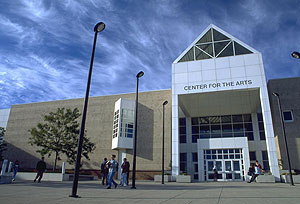
UB Art Gallery, Center for the Arts, exterior.
|
RH: What brought you to the University at Buffalo in 2001?
SHO: First, the opportunity to work at a large, research-based university with outstanding faculty and students in so many different departments. It offered the potential for nearly endless interdisciplinary opportunities. For example, the extraordinary opportunity to work with Gao Minglu, then Assistant Professor in the Department of Art History, to organize and install the collaborative exhibition The Wall: Reshaping Contemporary Chinese Art (October, 2005 – January, 2006), and the concurrent interdisciplinary, international academic conference with faculty in the history and anthropology departments, the Asia Studies Program, and the Law School. Second, the unique opportunity to initiate the university’s first art museum because of David Anderson’s generous gift to the university — the UB Anderson Gallery. Third, it offered the rare opportunity of working in two very different galleries: UB Art Gallery in the Center for the Arts (CFA), on the main campus, dedicated to presenting temporary exhibitions reflecting current issues and practice in the visual arts and UB Anderson Gallery, located in an urban neighborhood, which serves not only as the university’s museum but as an academic center for research and professional practice.
RH: What are your specific areas of interest at UB?
SHO: My specific interests are to provide unique opportunities for discourse on the arts (in the broadest sense of the word) at the Center for the Arts by presenting temporary exhibitions of contemporary art, by offering exhibition space for faculty and students in various departments (the second floor gallery from art, media study, literature, schools of music and architecture) and organizing related events (lectures, conferences and workshops) that engage our faculty and students and the WNY community. At UB Anderson Gallery, my specific interests are threefold: 1) to make accessible the museum’s unique resources by remodeling current spaces into a prints and drawings study room and a Martha Jackson archives and study room; 2) to utilize the house on adjacent property as a residency for visiting artists, curators or scholars; 3) to complete an extensive oral history project about Martha Jackson Gallery, which will culminate in an exhibition and publication on Martha Jackson’s important contribution to the development of the modern art.
RH: What has been the impact of adding the Anderson Gallery?
SHO: By adding Anderson Gallery, UB finally has an art museum for its collection and a research and professional training center for students interested in museum studies and now, arts management. The collection and archives from the Martha Jackson Gallery are important resources for the university and scholars of 20th century art. Located halfway between the North Campus and downtown, within the University Heights neighborhood, it serves also as an important place for university events, community events or for meetings, workshops and conferences that bring university and community members together, thereby enhancing the extensive community engagement of the university.
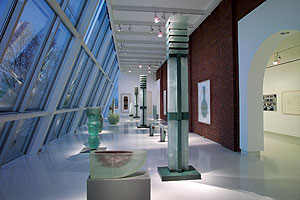
Ben Tre Atrium Installation at UB Anderson Gallery
Photo by Biff Henrich/Keystone Film Productions.
|
RH: How have these changes affected your personnel?
SHO: I am very fortunate to have professional staff at both galleries to support and maintain the professionalism required to handle and install valuable works of art. Therefore, we are able to obtain important loans from museums, collectors and artists. Although the galleries share some personnel (the director, and public relations officer) each facility has its own preparator/installer, registrar and administrative assistant, so that we can maintain a full schedule at both places. For very large and complex installations, the preparators and registrars can work together to provide unique exhibitions, such as The Art of Howard Ben Tré or they work together to install comprehensive exhibitions at both venues (Harvey Breverman and The Wall).
RH: Is there increased responsibility at UB?
SHO: Yes, because the mission of each gallery is different. In addition, the administrative structure and budget is different for each gallery. As director of the art gallery in CFA, I report to the Dean of the College of Arts and Sciences. As director of UB Anderson Gallery, owned by the University at Buffalo Foundation and off campus, I report to the Provost. This structure increases responsibility, but the advantages far outweigh any inconveniences. Since I serve both the university and the community, it is important for me to be aware of the academic and administrative goals for the university.
RH: Tell us about the future plans for the galleries and the program.
SHO: One of the reasons I spend more time in archives and study rooms these days is because of our plan to renovate the prints and drawings storage room into a study room, which will allow faculty, students and gallery visitors the opportunity to “learn to look” by closely examining and studying works on paper. In addition, we have plans for an Archives Research Center. Thanks to the assistance of a professional consultant and two very dedicated volunteers, the Martha Jackson Oral History Project is well underway. As I have mentioned, one of the important plans is a residency program that utilizes the house adjacent to UB Anderson Gallery.
RH: What is planned in conjunction with the Dalai Lama’s visit to UB in September?
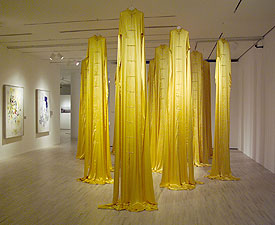
Moon Women installation at UB Art Gallery.
Photo by Biff Henrich/Keystone Film
Productions.
|
SHO: First, Tibetan monks will create a mandala sand painting in the first floor gallery, Center for the Arts, which will open with a consecration ceremony and close with the traditional deconstruction ceremony. A live feed will enable people to watch the monks make the sand painting over three days at various places on campus.
Second, in partnership with the School of Architecture and Planning, the first floor gallery will premiere an exhibition of the Druk White School architectural project for Ladakh, a community in the western Himalayas, just across the Tibetan border. Initiated in 1994 by the Drupka Kargyud Trust under the patronage of His Holiness the Dalai Lama, the overall plan is based on the eight-spoked dharma wheel, which represents Buddhist teachings, and the nine-square mandala. The project has been designed to utilize solar energy, respond to the extreme climate, use local materials so as to enable the community to assist in the construction of the buildings and conserve water. The school has received a number of significant international design prizes including a World Architecture Award. The UB School of Architecture is planning a concurrent lecture and workshop with members of the architectural design team.
Third, we hope to have a significant work of art on loan from the Rubin Museum of Himalayan Art in NYC.
Fourth, at UB Anderson Gallery we will exhibit Tibetan and Buddhist works of art on loan from local private collectors, particularly from Dr. Richard Lee who has conducted research in Ladakh with UB Medical students.
And finally, we will present two rose mandala installations by Chrysanne Stathacos; one in the glass atrium of UB Anderson Gallery and the other in an appropriate site, yet to be determined, on the North Campus.
RH: What exhibition is planned later this fall?
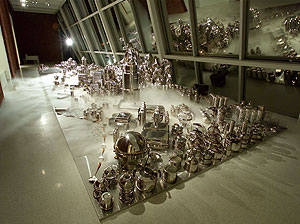
Urban Landscape installed at the UB Anderson Gallery
|
SHO: In November, a mid career retrospective exhibition for Kim Jones, the first occasion that the installations, performance documentation, drawings and sculptural objects of this New York-based artist have been brought together. Jones began his career in Los Angeles in the mid-1960s as a performance artist and became known for his alter ego, Mudman — a shaman-like itinerant caked in mud — that would appear on city streets, subways and galleries. In the 1980s Jones moved to New York, where he has continued to develop a powerful iconography haunted by war and destruction in the 20th century. This project aims to secure his position in art history as a dynamic and integral figure. Co-organized by Luckman Gallery, California Sate, Los Angeles, the exhibition will be accompanied by a 160-page monograph featuring at least four essays including exhibition curators Sandra Firmin and Julie Joyce, and Robert Storr, Rosalie Solow Professor of Modern and Contemporary Art at the Institute of Fine Arts, NYC. The exhibition and catalog have been made possible through the generous support of The Andy Warhol Foundation for the Visual Arts and The Fifth Floor Foundation.
RH: Is Buffalo a good city for artists and the arts?
SHO: Not only do I think it is one of the best cities for artists and the arts, but Buffalo was recently declared #1 in a recent American Style magazine poll (www.post-gazette.com/pg/06111/683859-42.stm). It is a great place for artists, not only because of the cultural climate, but also because housing and studio space is affordable. The collection at the Albright-Knox Art Gallery has served as an anchor for the development of a long tradition of support for and interest in the arts. Every collector and successful art dealer I know who grew up in Buffalo talks about the Saturday morning art classes they took as children at the Albright-Knox Art Gallery. The large number of universities provides intellectual support and professional research and training in the arts. The community and its support for the arts has produced an amazing number of talented artists and creative, ingenious individuals who have developed an array of unique cultural organizations that compete on national and international levels.
RH: What is your favorite thing about Buffalo?
SHO: My favorite thing is the fact that one can commute effortlessly in and out of the city. It allows my family to live less than a 35-minute commute to work and 40-minute drive to the airport, in one of the state’s most scenic areas, on an international border, in a historical village less than one mile from a significant historical site, which is surrounded by several state parks and nature preserves.
RH: What is one thing would you like to see changed?
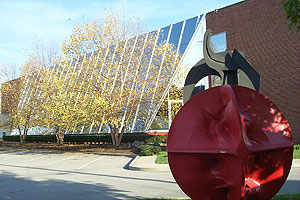
UB Anderson Gallery exterior.
|
SHO: The political and economic environment, particularly the long-suffering public education system.
RH: How have you balanced a demanding career while raising children?
SHO: By marrying Nils Olsen who has always shared at least 50% of the child care and housework and always supports my work. Also, my career and child rearing have never been segregated parts of my life. Our children learned to entertain themselves when we took them to work or to meetings with us; we studied and worked together, and our children have attended almost as many of my art openings as I have attended their sports or music events.
RH: How has your job differed from what you may have envisioned?
SHO: The never-expected opportunity to work on such a large-scale, international exhibition as The Wall. It was an extraordinary experience in so many ways; working with Gao Minglu, in collaboration with my colleagues at the Albright-Knox Art Gallery, the cultural diplomacy involved with organizing the exhibition with the Millennium Museum in Beijing, and the opportunity to visit artists in Beijing in their studios and homes.
RH: How does where you are now line-up with how you imagined yourself when you were younger?
SHO: While growing up on a farm in Wisconsin, I dreamed of a job with opportunities to travel and to meet interesting and exciting people. My mother claimed that I always wanted to be in charge of a school or museum. I guess I am closer to that dream than I imagined.
Robert Hirsch
Back to Top
|